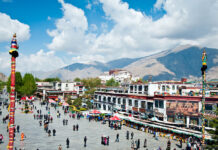(TibetanReview.net, Jul13’21) – Many residents in Tibet’s capital Lhasa agree that modernisations are welcome, but experts have warned that the city’s 860,000 residents are also increasingly polarised between haves and have-nots, reports the AFP Jul 13, following a rare and tightly controlled government-led tour of Tibet for a group of journalists.
The residential building binge is perhaps the most visible evidence of this polarisation, seen as largely benefitting educated Chinese and Tibetan government workers while the mostly rural Tibetan migrants struggle to keep up.
The report says the construction boom had created a two-tier system of property wealth between state workers and everyone else.
A huge infrastructure and building drive in Tibet (meaning Tibet Autonomous Region, or TAR) has brought airports, roads, railways and new flats, which Beijing says are improving life across the remote mountainous plateau. But the boom is also changing the historic Buddhist city and pushing property prices out of reach of many residents, the report cited Tibetans as saying, sharpening divisions in a region well-known for discontent under Chinese control.
The report cited the example of a high-end condo towers being built by Chinese developer Country Garden, a short distance from the Potala Palace, historically the winter residence of the Dalai Lamas.
They are priced similarly to many major Chinese cities, despite average Tibetan incomes still being among the country’s lowest, the report notes.
The report says real estate listings show around three dozen new developments currently selling homes in Lhasa.
The report notes that while the Chinese government says development is the antidote to discontent in Tibet, many Tibetans still revere the Dalai Lama – their spiritual leader – and resent an influx of Chinese tourists and settlers.
While having a government job is the gateway to becoming a propertied citizen, Chinese immigrants and their children grab much of the opportunities in this sector because of their better Mandarin fluency and official rapport.
“Most people who are educated work for the government. (But) you have increasing numbers of young Tibetans who are well-educated… and didn’t get a government job,” the report quoted an overseas Tibetan who spoke on condition of anonymity as saying.
Other obstacles facing Tibetans in seeking government jobs include such workers facing extra controls and pressure to shun their Buddhist faith, which they fear endangers their religious and cultural heritage, the report notes.
There is no public data on the ethnicity of TAR’s state workers, the report noted. Past official reports have spoken only about the proportion of females in the state force in TAR.
Census data shows that numbers of Han Chinese – the country’s dominant ethnic group – have grown over the past decade to comprise 12% of TAR’s overall population, fostering yet more competition for jobs, the report noted.
Tibetans suspect that the percentage of Chinese immigrant population in TAR is much higher, with the government deliberately undercounting them for propaganda reasons.






